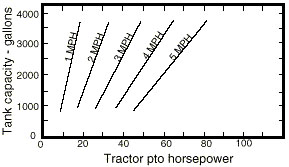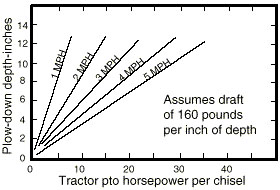The land area required for biosolids depends upon the amount and characteristics of biosolids produced, and the crops, soils characteristics and agronomic practices used. The amount of land that must be covered influences decisions on types and sizes of equipment needed to manage biosolids. The following table is an estimate of land area requirements for various size municipalities.
Table 1
Estimate1 of area required for land application of biosolids for different size municipalities.
| Population | Area,2 acres |
|---|---|
| 3,000 | 30 |
| 5,000 | 50 |
| 7,000 | 70 |
| 10,000 | 100 |
| 20,000 | 200 |
| 50,000 | 500 |
1These values are estimates only. Actual land area requirements must be based on the amount and characteristics of biosolids produced, and the crops, soils, and agronomic practices utilized.
2Assumes 100 dry tons biosolids per year per 5,000 people. This is typical for treatment plants with extended aeration. Activated sludge plants, or trickling filters may yield up to 40 percent more biosolids than plants with extended aeration. Biosolids application rate assumed to be 2 dry tons per acre per year.
Biosolids application equipment should be selected and managed with the above acreages in mind.
Many operational requirements or considerations must be addressed in the land application of biosolids. A primary objective in biosolids application is to apply a target amount of nutrients to the land as precisely as possible. This requires proper coordination of pumping rate, or applicator discharge rate and applicator travel speed with the equipment discussed above. Other applicable factors include nutrient concentration in the biosolids and the desired nutrient application rate (pounds per acre). The following formulas can be used to calculate appropriate parameters for the application of liquid biosolids. For similar calculations involving cake biosolids (spread with mechanical spreaders) see MU publications WQ213, Measuring Manure Spreader Uniformity.
Area covered, travel speed, applicator width:
Equation 1
A = 0.1212 x S x W
A = area covered, acres per hour
S = applicator travel speed, miles per hour
W = effective applicator width, feet
Nutrient concentration, application rate, discharge rate:
Equation 2
S = (C x D x 0.00415)/ R x W
C = nutrient concentration in biosolids, wet basis or "as is," ppm
D = applicator discharge rate, gallons per minute
R = nutrient application rate, pounds per acre
The following conversion formula may be useful in obtaining wet basis nutrient concentration:
nutrient concentration, wet basis = nutrient concentration, dry basis x percent dry matter/100
Travel speed, gallons spread per acre:
Equation 3
S = (D x 495)/G x W
G = gallons spread per acre
Example 1
Certain biosolids have a nitrogen concentration (wet basis) of 1,620 ppm and a dry matter content of 3 percent. It is desired to land-apply these biosolids such that the nitrogen application rate is 180 pounds per acre. The applicator to be used has 4 injector knives on 2.5-foot spacing (effective applicator width = 4 x 2.5 = 10 feet), and is capable of discharging biosolids at a rate of 450 gpm.
What travel speed should the operator use to obtain the desired nitrogen application rate, how many gallons will be spread per acre, and at what rate (acres per hour) will the area be covered?
Travel speed is calculated from Equation 2.
S = (1,620 x 450 x 0.00415)/ 180 x 10 = 1.7 miles per hour
Gallons spread per acre is calculated from Equation 3.
G = (450 x 495)/1.7 x 10 = 13,100 gallons per acre
Acres covered per hour is calculated from Equation 1.
A = 0.1212 x 1.7 x 10 = 2.06 acres per hour
Example 2
What travel speed should be used if it is desired to apply two dry tons per acre biosolids?
In this case, the nutrient is dry tons, and the application rate is 4,000 pounds per acre. The wet basis nutrient concentration is 3 percent, or 30,000 ppm. Equation 2 is then calculated as follows.
S = (30,000 x 450 x 0.00415)/4,000 x 10 = 1.4 miles per hour
The above equations can be manipulated algebraically to solve for any of the desired parameters.
Another consideration in off-site application may be power requirements for applicators. This is especially true in the case of farm tractors that may be used to pull tank wagons that inject biosolids into the ground. Figures 1 and 2 show approximate power requirements for pulling loaded tank wagons and injector knives through soil. These figures in equation form are as follows.
 Figure 1
Figure 1
Approximate tractor size (PTO Horsepower) needed to pull a tank wagon of a given capacity through a plowed field at speeds of 1 to 5 miles per hour.
 Figure 2
Figure 2
Approximate tractor size (PTO Horsepower) needed to inject biosolids with chisels at speeds shown, in heavy soils and sod.
Equation 4
HPT = (0.002129 x S + 0.001265)V + (7.9755 x S) - 3.7525
Equation 5
HPI = 0.566 x S x D x N
HPT = approximate tractor horsepower required to pull a manure tank with volume V through a plowed field at speed S
HPI = approximate tractor horsepower required to pull an injector unit with N number of chisels at depth D, and speed S
S = speed traveled, miles per hour
V = tankwagon volume, gallons
D = depth of chisels, inches
N = number of chisels
Example 3
A 4,000-gallon tank wagon with a 5-chisel injection unit is available to land-apply biosolids. If the tankwagon is pulled at 4 miles per hour, and the biosolids are injected to a depth of 10 inches, what approximate tractor horsepower will be required?
Power required to pull the tank wagon:
HPT = (0.002129 x 4 + 0.001265) 4,000 + (7.9755 x 4) - 3.7525 = 67 horsepower
Power required to pull the injector unit:
HPI = 0.566 x 4 x 10 x 5 = 113 horsepower
Total power requirement:
67 + 113 = 180 horsepower
Another consideration in the off-site application of biosolids is the effect of travel time (distance of the site from the treatment plant) on the field efficiency of the applicator. As travel time for the tanker increases, applicator downtime in the field will increase because there will be more waiting time for the tanker. Increasing the number of tankers and the volume of the tankers relative to the applicator will reduce this downtime. The following equation provides an estimate of the percent downtime (time the applicator is waiting, neither loading or applying) for the applicator as a function of several variables.
PDT = ((TV/AV) TAL + (TV/AV - 1) TAU + RT - N (TV/AV) (TAL + TAU)) / ((TV/AV) TAL + (TV/AV - 1) TAU + RT) x 100
PDT = percent downtime for applicator in field
TV = tanker volume, gallons
AV = applicator volume, gallons
TAL = time to load applicator from tanker, minutes
TAU = time to unload, or apply from applicator, minutes
RT = round trip time for tanker (site to treatment plant, load and back to site), minutes
N = number of tankers
Example 4
A 3,000 gallon applicator is to be supplied by a 3,000 gallon tanker in an off-site biosolids operation. Average time to load the applicator from the tanker is 12 minutes. Average time for the applicator to apply the 3,000 gallon load is 10 minutes. One-way travel time for the tanker is 20 minutes, and loading time at the treatment plant averages 10 minutes, for a round-trip total of 50 minutes.
What percent applicator downtime could be expected in this operation? What would be the effect of using two 3,000 gallon tankers? What would be the effect of using one 6,000 gallon tanker?
PDT = ((3,000 ÷ 3,000) 12 + (3,000 ÷ 3,000 - 1) 10 + 50 - 1 (3,000 ÷ 3,000) (12+10)) / ((3,000 ÷ 3,000) 12 + (3,000 ÷ 3,000 - 1) 10 + 50) x 100 = 64.5 percent
If two 3,000 gallon tankers were used, PDT is calculated as follows.
PDT = ((3,000 / 3,000) 12 + (3,000 / 3,000 - 1) 10 + 50 - 2 (3,000 / 3,000) (12 + 10)) / ((3,000 / 3,000) 12 + (3,000 / 3,000 - 1) 10 + 500) x 100 = 29 percent
If one 6,000 gallon tanker were used, PDT is calculated as follows.
PDT = ((6,000 / 3,000) 12 + (6,000 / 3,000 - 1) 10 + 50 - 1 (6,000 / 3,000) (12+10) ) / ((6,000 /; 3,000) 12 + (6,000 / 3,000 - 1) 10 + 50) x 100 = 47.6 percent
The effect of faster loading and unloading times, or reducing round trip time by pumping part way to the site, can be evaluated by adjusting the appropriate inputs. A negative value for PDT indicates no waiting time for the applicator (no downtime).
References
- City of Columbia, Columbia Wastewater Treatment Plant, Sludge Management Program.
- Missouri Department of Natural Resources, Division of Environmental Quality. Agricultural Use of Municipal Wastewater Sludge — a planning guide. January 1985.
- USEPA. Biosolids Technology Fact Sheet: Land Application of Biosolids EPA 832-F-00-064, September 2000.
- Lu, Q., He, Z. L., and Stoffell, P. J. Land Application of Biosolids in the USA: A Review. Applied and Environmental Soil Science, Volume 2012, Article ID 201462, doi:10.1155/2012/201462